Some early finds Wednesday, July 23rd, 2014
|
|
|
|
|
We are now on day 3 of Plugstreet 2014. We have got a wide variety of finds coming out of the trenches at Chateau de la Hutte and Plugstreet Wood._
The Finds Team always get quite excited when we can identify and provenance some of the objects we receive. For example, the bottle fragment below didn’t look much when it came in. After cleaning we could read the words “Royal Warrant”. Some cursory research revealed this is likely an Idris Ginger Beer bottle – a delightfully British find in rural Belgium! Lots of complete bottles of this type have been found on the Somme battlefields.
_
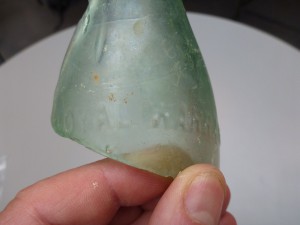 Idris Ginger Beer bottle _
Although most people think of fighting in this part of Belgium being associated with the First World War and especially the Battle of Messines in 1917. However this ground also was fought over during May 1940 when parts of the British Expeditionary Force attempted to delay the German advance and keep the “Dunkirk corridor” open for a bit longer. We were excited to find some German cartridge cases. These were cleaned to reveal the headstamps (markings on the base of the case which indicate such things as date and place of manufacture). In this case we had one brass case round made in Magdeburg in 1936, while others were of copper coated steel made in 1938/39. _
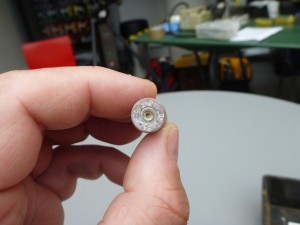 German Mauser round |
|
|
|
|
|
Filed under: A Dig Diary, Archaeology by
Finds Room
Add a Comment »
|
|
Back in Plugstreet Monday, July 21st, 2014
|
|
|
|
|
The team assembled outside the Auberge at 9am today. This year we are investigating two sites behind the front line, one a point marked on the maps from 1917 onwards, the other situated on the highest land in Allied hands prior to the Battle of Messines.
_
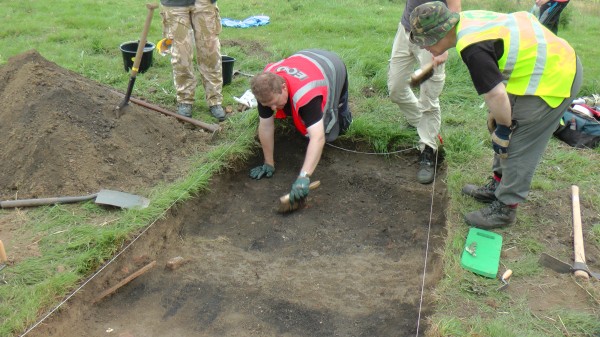
_
On of our two trenches in the grounds of La Hutte Chateau, with a curious spread of cinders and debris from the building.
_
_
The other trench has also revealed a small amount of demolition rubble and evidence of communication wire.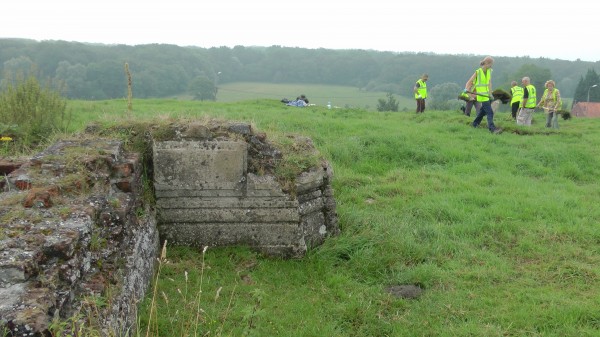
_
In the woods we have opened two trenches, one in search of the light railway, the other in search of the feature on the maps.
_
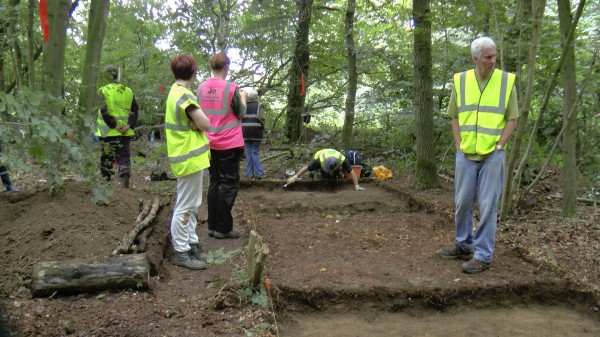
_
|
|
|
|
|
|
Filed under: A Dig Diary by
PlugStreetTeam
1 Comment »
|
|
In preparation for our 2014 excavations Monday, July 14th, 2014
|
|
|
|
|
The team are currently preparing for the 2014 trip to the battlefields. As you can imagine a lot of work goes into researching potential targets for excavation long before we arrive on site, many hours are spent examining maps, documents, war diaries and photographs alongside geophysics results in order to maximize our limited time in the field.
_
As this year sees the centenary of the start of the Great War, team members have been exceptionally busy all year with our own projects and working with other groups to help others learn about their own families and local communities. Already we have seen a large increase in the volume of contributions of stories and photos of those who took part in the Battle of Messines to be listed on our website, every one unique and a great addition to building the bigger picture of events. If your relative was one of the many men involved in the battle, please consider adding their name to our site along with any details you have.
_
If you are looking for help with researching your relative, you may find the The Wartime Memories Project help with research useful, they also have a huge collection of stories from all aspects of the war.
_
We have also recently been sent a copy of the excellent free booklet 1914-1919 As Reported At The Time, which has been produced by Historic Newspapers as a teaching resource. Teachers and education institutions can apply for a copy via the link.
|
|
|
|
|
|
Filed under: A Dig Diary, Archaeology by
PlugStreetTeam
Add a Comment »
|
|
Our work on Cannock Chase Tuesday, October 22nd, 2013
|
|
|
|
|
Last night 21st October 2013, Inside Out West Midlands featured our work on the Cannock Chase Model of Messines. If you missed it you can catch it on iPlayer until next Monday. Inside Out on iPlayer
Further information and photos from our site are available on the Great War Cannock Blog
|
|
|
|
|
|
Filed under: Archaeology by
admin
Add a Comment »
|
|
Preparing for the Cannock Chase excavation Tuesday, September 3rd, 2013
|
|
Filed under: A Dig Diary by
PlugStreetTeam
Add a Comment »
|
|
Operation Kiwi Tuesday, August 13th, 2013
|
|
|
|
|
For our 2013 Season we will be undertaking work a little closer to home, but with a strong link to our work at Plugstreet. Between the 7th and 29th of September 2013, No Man’s Land will be working with Staffordshire County Council to excavate the Messines Model on Cannock Chase.
During the Great War significant training camps and attendant facilities were established on Cannock Chase. These included two Divisional training camps, roads, railways, power station, ranges, training trenches and instructional models.
One of the most unusual Great War features identified is a scale model of a sector of the Western Front. Such models are known from Allied Reserve areas where they were used for instructional purposes ahead of an offensive. A well-known example was created south of Ypres in advance of the 1917 Battle of Messines, and the Australian War Memorial holds a number of photographs of troops inspecting the model. A second example is said to have been created ahead of the Battle of Cambrai (Peter Simkins, pers. comm.) also from 1917. However, neither model is believed to have survived and, more significantly, no other examples are known from the UK.
The Cannock model is believed to have been constructed by members of the New Zealand Rifle Brigade (NZRB) who captured the village of Messines during the battle. The model is known to have survived into the inter-war years when it became a tourist attraction with an attendant who acted as guide to the site. With the onset of World War II, and the return of military training to the Chase the site became overgrown and was lost.
We are looking for volunteers to join us for this unique opportunity, please telephone 0121 449 6563 or email cannockwwiexcavations@gmail.com to register your interest and book a place.
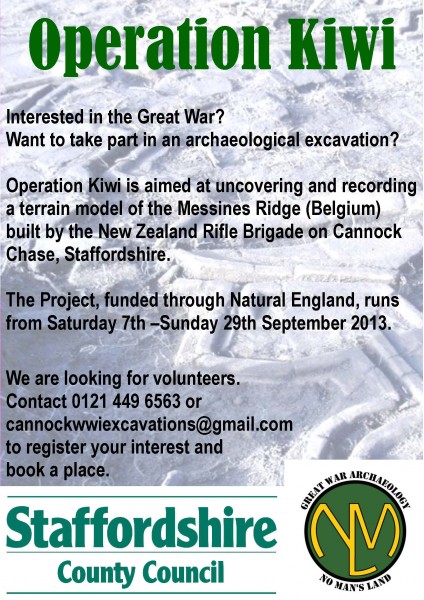
|
|
|
|
|
|
Filed under: Archaeology, Great War History by
admin
Add a Comment »
|
|
Congratulations! Monday, July 29th, 2013
|
|
|
|
|
The entire project team would like to extend their congratulations to Avril and James MacNaughton, two of the core team at Plugstreet, on the occasion of their wedding in Chandler Arizona on Saturday 27th August 2013. With our best wishes for a long and happy life together.
|
|
|
|
|
|
Filed under: Uncategorized by
admin
Add a Comment »
|
|
Laying of the First Stone Tuesday, May 8th, 2012
|
|
|
|
|
Last week, the ceremonial first stone of the Plugstreet 14-18 Interpretation Centre was laid by The Australian Ambassador, Dr Brendan Nelson, and Mayor Gilbert Deleu.
Gilbert Deleu said: “Comines-Warneton is the only territory of Wallonia, which was occupied by the belligerent forces, with Ploegsteert as the southernmost part of the Ypres Salient. Within two kilometers, there are thirteen cemeteries, 35 concrete structures, four craters and the Catacombs appointed in 1917. The goal is to absorb the experiences of soldiers and civilians. The set design is based on testimonies, photographs, maps, relics and newspapers through international collaborations with British and Australian historians and at the initiative of a scientific committee, the Walloon Association for Heritage and Archaeological Historical Society of Comines-Warneton. ”
Watch the local news report
The Plugstreet Tem are proud to be involved and we look forward to seeing the development of the site.
|
|
|
|
|
|
Filed under: Uncategorized by
PlugStreetTeam
Add a Comment »
|
|
|
|
|
|